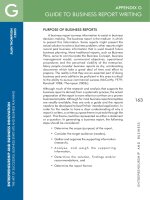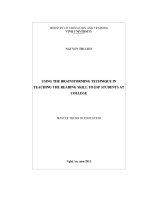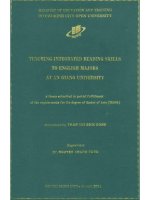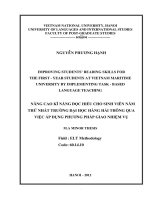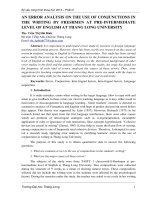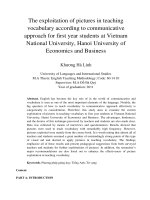Strategies for teaching business report writing to language students at thang long university
Bạn đang xem bản rút gọn của tài liệu. Xem và tải ngay bản đầy đủ của tài liệu tại đây (412.27 KB, 90 trang )
PART ONE
Introduction
RATIONALE
Writing business reports is one of the fundamental business writing skills. Business
reports here are understood as "documents that present information on a specific topic for a
specific business purpose" (Boone, 1996: 308). Nearly all business activities involve writing
business reports, from analyzing the status of projects, summarizing business trips, to
investigating an arising problem or suggesting a change in an organization. Writing reports
sometimes becomes professional services which are provided for a fee. The job of market
research companies, for example, is to write reports on the results from their researches on
consumers' demands for a particular product or service. Writing effective reports is an
essential skill for office workers and should be taken into consideration in language
education in colleges, especially for language students who are likely to be office staff after
graduation.
The teaching of business reports in English is a part of courses of English for
business communication, a branch of English for Specific Purposes. English-major students,
however, have to face a number of problems when studying English as a means of business
communication. First, most of the students are not familiar with business knowledge. Most
of them have never taken part in any business activities so far. Business courses, if any,
provide just general theories of economics. Second, the materials used for the courses are not
usually tailored for language students to learn to write business reports in English
intensively. In Vietnam, some intensive courses of English for Business Communication
have to use materials for low-intensive courses and/or those written for English native
1
speakers to study business communication with English as the first language. Those
materials can neither provide a thorough understanding of the subject nor anticipate the lack
of language competence of foreign language learners.
The knowledge of writing business reports in English is considered a need for
English-major students who will soon graduate and might have to use the knowledge in
working life. However, as a newly established non-state university, Thang Long has a
remarkable number of problems in dealing with the matter. Firstly, the university staff, most
of which are little informed teachers of English, has to begin designing the syllabus from
nothing but references from several similar available ones. As for the courses of English for
Business Communication, it is hard to find a relevant syllabus so the staff has chosen to rely
on a textbook written for improving business communication skill for native speakers.
Besides, as language-major students, students with English major find it really difficult to
deal with business issues, let alone writing reports on the subject.
With those difficulties, the teaching of English for business communication in
general and writing business reports in English in particular is really a challenge. What the
teacher can do now is to develop effective teaching strategies that help students understand
the subject knowledge presented in the textbook, design useful exercises for practicing both
language aspects and writing skills and avoid making errors in writing business reports. The
study, therefore, is proposed to find out those necessary teaching strategies for the section of
teaching how to write business reports in the course of English for Business Communication
3 at Thang Long University.
2
PURPOSES OF THE STUDY
The research questions are:
1. What do language students need in learning to write business reports in English?
2. What are the difficulties for language students in learning to write business
reports in English?
3. What are common errors made by students in writing business reports in English?
4. What are effective strategies for teaching writing business reports in English?
From all of these, it is understood that the study aims at finding out effective and
appropriate teaching strategies to achieve more satisfying results for the course. The
satisfying results can be understood as students' ability to convey factual information
efficiently and cohesively. Written texts must also lead to insightful and frequently profitable
solutions. It is required that business report writers address specific audience and pay
attention to appropriate format and design issues so that a finished document can be closely
read or efficiently skimmed. Evaluation criteria should include attention to students' address
of assignment, use of persuasive insights, consistent address of target audience, and ability to
create effective summaries, headings, subheadings, lists and short paragraphs. Lastly, reports
must be expressed in accurate, appropriate and effective sentence structures, lexical items,
orthography and styles.
It is surprising that although business reports in English are used frequently in most
foreign offices in Vietnam, there have not been many studies on this aspect of business
writing or business communication. This study attempts not only to look into the existing
methodologies but also to find out distinctive features of the teaching context at Thang Long
University and language students to apply these methodologies appropriately.
3
SCOPE OF THE STUDY
The study focuses on the teaching process of the section of writing business reports
in the course English for Business Communication 3 at Thang Long University. It tries to
suggest effective teaching strategies that can be used in the course. A strategy can be
understood as "a carefully devised plan of action to achieve a goal, or the art of developing
or carrying out such a plan" (Encarta Reference Library 2004). Teaching strategies,
therefore, can be understood as plans of action in order to achieve a goal in teaching. In this
language content-based course, the language teacher also plays the role of an instructor who
teaches skills. The strategies, therefore, are for teaching both language and skills. The
subjects of the study are language students who major in English, not students with business
major.
The study does not deal with other kinds of reports apart from business reports used
in business activities, i.e. activities performed in organizations operating in order to provide
goods or services. English is used in these activities to facilitate communication involving
people speaking English as the first, second or foreign language. The study only tries to find
out teaching strategies to help students learn how to write business reports with the aspects
including language, research methods, visual aid design, writing process and organizational
structure. It does not try to suggest the needed changes of other aspects of the course and
curriculum designs, such as time allotted for the course, facility settings, class size, and
student assessment.
METHODOLOGY
The paper will present a review from published materials in the related fields. Also, a
needs analysis will be conducted among the existing students of English major in order to
4
find out whether language students at Thang Long University consider teaching report
writing useful and find out the prepared teaching methods, their expectations from, their
difficulties in and their recommendations for the course. Lastly, an error analysis of students'
writing samples is used to identify the common errors made by the students in writing
business reports in English.
Books, articles and Internet resources on English for Business Purposes, teaching
English writing and business reports are collected to examine the history of the fields and to
provide available suggestions in the practice of teaching business report writing. Next, the
needs analysis is conducted through a questionnaire survey of students who are taking the
course of English for Business Communication 3 at Thang Long University.
The analysis of errors in writing samples is used in order to find out common errors
students often make when writing business reports in English. This can help the teacher
anticipate problems in the existing course and look for proper ways to deal with these
common errors and solve those problems. The analysis also helps find out the strengths and
drawbacks of the course, which may result in appropriate adjustments in the course contents
as well as the teaching techniques of the teacher. The primary data combine both qualitative
and quantitative methods with both open and closed questions in the questionnaire designed
for the needs analysis, and the error analysis in texts written by students.
CONTENTS OF THE STUDY
The study includes four chapters, Chapter 1 presents a review on literature, Chapter 2
deals with the research description, Chapter 3 shows the interpretation of data analyses, and
implications for teaching how to write business reports in English for English-major students
are recommended in Chapter 4.
5
In Chapter 1, the trends and approaches of English for Specific Purposes are
examined and later narrowed down to English for Business Purposes. Also, the chapter will
trace down the approaches of teaching writing as well as analyze writing tasks and activities
in a classroom. Lastly, the chapter presents features of business reports as a genre with
analysis on its classification, rhetorical patterns, linguistic features and the writing process.
Chapter 2 describes the study of needs analysis and the error analysis of the students'
writing samples. In Chapter 3, the data of the two researches are analyzed to draw useful
conclusions and implications. Firstly, the needs analysis questionnaire responses are put
together and evaluated. The results will review the students' needs on the course content,
methodologies, and their recommendations. Secondly, the results of the error analysis are
presented to see the weakness of students' writing skills.
Based on the review of literature and the data analysis in the Chapter 1 and 3,
Chapter 4 will present key points of the studies: implications for teaching to write business
reports. The chapter will follow the teaching process from presenting the knowledge in the
content-based course including analyzing sample reports, giving practice exercises, and
managing errors in these writing exercises.
6
PART TWO
The Study
CHAPTER I
Literature Review
I.1. ENGLISH FOR BUSINESS PURPOSES (EBP) IN AN ENGLISH FOR SPECIFIC
PURPOSES (ESP) CONTEXT
I.1.1. DEFINITIONS OF ESP
Despite appearing first in as far as the 1960s, ESP has not had an agreed-upon
definition so far. Hutchinson and Waters (1987: 19) emphasized, "ESP should probably be
seen not as any particular language product but as an approach to language teaching which is
directed by specific and apparent reasons for learning." English language teaching with ESP
approach, therefore, becomes more targeted to the learner's needs and creates more
motivation to the learner.
Dudley-Evans and St John (1998: 4-5) have modified a definition of ESP by
Strevens' into one including absolute and variable characteristics as follows:
Absolute characteristics:
• ESP is defined to meet specific needs of the learner;
• ESP makes use of the underlying methodology and activities of
the discipline it serves;
• ESP is centered on the language (grammar, lexis, register), skills,
discourse and genres appropriate to these activities.
Variable Characteristics
• ESP may be related to or designed for specific discipline;
• ESP may use, in specific teaching situation, a different
methodology from that of General English;
• ESP is likely to be designed for adult learners, either at a tertiary
level institution or in a professional work situation. It could,
however, be for learners at secondary school level;
• ESP is generally designed for intermediate or advanced students;
7
• Most ESP courses assume some basic knowledge of the language
system, but it can be used with beginners.
(Dudley-Evans and St John, 1998: 4-5)
With these two views, it can be concluded that ESP is closely related with the needs
of language learners in their use of English in their fields of professions or studies. Also,
ESP includes a number of variations that can be flexibly adjusted to fit the various needs of
learners.
I.1.2. CLASSIFICATIONS OF ESP
Hutchinson and Waters (1987: 17) and Dudley-Evans and St John (1998: 6) build
similar trees for different divisions of ESP in which ESP is divided into such branches as
English for Science and Technology (EST), English for Business and Economics (EBE), and
English for Social Sciences (ESS), and further to English for Academic Purposes (EAP) and
English for Occupational Purposes (EOP) or Business Purposes (EBP) from English for
Management, Finance and Economics, and English for Business and Economics (EBE).
Dudley-Evans and St John, on the other hand, suggested the use of a continuum with
degrees of specificity, in which the higher the level is, the more specific the course becomes,
accompanying with the levels of English. Martin (1992: 40) also gave a thorough description
of several degrees of specificity, from more specific courses to more general courses, and no
restrictions on the language levels, as presented in Figure I-1.
The use of degrees of speficity of ESP course helps clarify English courses. Courses
in type V will not be considered ESP courses due to the far too indirect link to the
professional areas. On the other hand, type I courses are the most specific courses and can be
applied to learners with clear professional target.
Degrees of Targets Objectives Text-types
8
specificity
Type I
very specifiable /
predictable / routine
narrow skills (content
secondary)
specific, routine
Type II
specifiable / predictable in
term of types
skill and some content can be identified as
genres, routine and non-
routine
Type III
half specifiable, half
unpredictable
content and skill balanced a wide range of definable
types
Type IV
primarily not predictable,
but with some important
specifiable elements
content-focused skill-
subordinate
wide range of variable,
unpredictable
Type V
very few specifiable or
predictable
both skills and content wide range, unpredictable
Source: Adapted from Martin, 1992: 40.
Figure I-1: The Five Degrees of Specificity of ESP courses
In conclusion, the use the tree systems can be used in defining the branches of ESP
and different disciplines that English can be used in, while the continuum can be seen as an
effective tool in defining the courses of ESP in practice and in deciding the elements of those
courses. Both the tree system and the continuum are relevant in classifying EBP courses in
the teaching context of the study.
I.1.3. TRENDS AND APPROACHES IN ESP
Nelson (2000) worked out an overview of the different ideas on the different trends
or approaches of ESP. ESP has experienced a number of phases: register analysis, rhetorical
and discourse analysis, needs analysis, skills and strategies, and learning-centered approach.
These phases will be presented in the chronological order. However, because ESP develops
at different paces in different countries in the world and what is old in one situation may still
9
be appropriate and useful in another context, all the above trends can be seen in practice
(Hutchinson, 1987: 9).
I.1.3.1. Register Analysis
Register analysis is the special language that is considered suitable for a specific
situation. For example, the English used in computer science must be different from that in
psychology. Swales (1988, as cited by Dudley-Evans and St John 1988:21) assumes that
while the basic grammar is not different in different circumstances, certain forms of
grammatical and lexical forms occur more frequently than other forms in one circumstance
and than the same forms in other circumstances. The concept of register or a special
language has been applied in language teaching in that some registers are emphasized in the
materials and syllabuses of language courses.
The analysis of those registers has been considered to be of little value as it is not a
reliable basis for ESP courses to just focus on simply teaching the linguistic elements that
are special in the context. However, with new computerized methods, for example, the
development corpus analysis, register analysis is now coming back.
I.1.3.2. Rhetorical or Discourse Analysis
The next stage of development in ESP accompanies the development of field
discourse analysis. Discourse analysis examines language in a higher level than the sentential
level in register analysis, the text. The key factor of discourse analysis is the rhetorical
patterns and the linking devices in a text. The ESP textbooks written based on discourse
analysis concentrate on the rhetorical functions of different forms of language and the
coherence and cohesion of the text.
10
The later phase of discourse analysis is genre analysis. According to Swales (1990:
58) as cited by Nelson (2000), "genre comprises a class of communicative events, the
members of which share some set of communicative purposes." In fact, genre analysis adds
cultural and social settings into discourse analysis.
I.1.3.3. Needs Analysis
Needs analysis is neither special to language teaching nor, within language teaching,
to LSP. Needs analysis include analyses of the target situation - the situation in which
learners will use the language they are learning, the language/genre/discourse, the subjective
needs, the learning needs, and the present situation of the learner's current skill and language
use (Dudley-Evans and St John, 1998). The needs analysis will provide useful and thorough
information so that the teaching implemented can meet these needs.
I.1.3.4. Analysis of Study Skills and Strategies
In the linguistic field, of discourse analysis, no special attention was given to the
necessary language skills. Then came the communicative language teaching movement
which puts a priority on the four skills, beginning with reading and writing, and then
listening and speaking. In English courses during that time, the language knowledge was
developed together with the ability to communicate using the knowledge.
However, not only individual skills are mentioned, the underlying competence is also
an important factor. This refers to the ability to reason and interpret the meaning. The focus
of reading skill, for example, is not only on the comprehension of the text but also on the
ability to guess the meaning regardless of unknown language items. Learners are required to
learn the strategies as well as the skills.
11
I.1.3.5. A Learning-Centered Approach
Hutchinson and Waters (1987) successfully moved from the above language-
centered approaches to a learning-centered approach. Hutchinson and Waters considered
other approaches to have "flaw" on focusing on language, not on learning, and the learning-
centered approach is underlied by the theory related to the language learning process.
I.1.3.6. Content-Based Language Instruction
Content-based instruction is considered as the new paradigm in language education,
which helps improving learners' language while studying a subject matter (Dueñas, 2003).
According to Brinton, Snow and Wesche (1989, p. 2) as cited by Halvorsen (1995) content-
based teaching is "the concurrent teaching of academic subject matter and second language
skills." The two purposes are inter-woven; the target language is the medium for
communicating information about the content subject while the content offers the context for
learning language skills.
According to Dueñas (2003), content-based language instruction has a number of
advantages. Firstly, content-based language courses provide a considerable amount of
language input. Secondly, the content-based instruction “support contextualized learning”;
the context is the subject matter presented in the target language, resulting in meaningful
communication, “rather than isolated language fragment.” Another benefit is the coherent
and systematic content of the subject matter allows students to refer to their prior language.
Moreover, in content-based learning, learners learn the language to express the unknown and
challenging content, which creates “intrinsic motivation.” Besides, content-based instruction
develops students’ learning strategies because the dual purposes require students to have
12
suitable strategies in various learning tasks. Also, the activities and curriculum in these
courses can be flexible and adaptable. Lastly, content-based allows student-centered
activities.
I.1.3.7. ESP Today
Few changes have been recorded since the work of Hutchinson and Waters (1987).
However, there can be two factors that make the character of ESP today. One is the rise of
English for Business Purposes (EBP), which is seen as "currently the area of greatest activity
and growth in ESP" (Dudley-Evans and St John 1998:53). The other is that ESP is now
experiencing an "eclectic period" (Nelson, 2000) in which the courses are designed by
mixing up different elements to fit the learners' particular situation.
I.1.4. ENGLISH FOR BUSINESS PURPOSES (EBP): A DEVELOPING BRANCH OF
ESP
With the globalization of trade, Business English or English for Business Purposes
(EBP) has become the fastest growing field in ESP. EBP has been researched thoroughly by
a number of authors. Dudley-Evans and St John (1998:53) summarized Pickett's argument
that EBP has a lot in common with everyday language of the general public. He also
suggests two aspects of business communication: communication with the public and
communication within a company and between companies (Pickett, 1986: 16).
Brieger (as cited in Nelson 2000) defines that Business English consists of language
knowledge (grammar, vocabulary, pronunciation, etc.) and communication skills (giving
presentations, meeting, telephoning, report writing, etc.) This definition puts an emphasis on
the language and skills in a business context not business knowledge. Nelson (2000) argues
13
that all the descriptions of EBP are much to simplistic of the broad scope of Business
English today.
According to Dudley-Evans (1998:53-54), because of its popularity, English is a key
to international business communications. It is spoken not only among people from English-
speaking countries, or between native speakers and non-native speakers, but more
commonly, among non-native speakers who do not share the first language.
One consequence of this is that non-native speakers can understand each other more
easily when communicating in English than they can understand native-speakers and than
native speakers can understand them. Another consequence is that the English spoken among
non-native speakers is different from that spoken among native speakers.
I.2. TEACHING ENGLISH WRITING
In this part of the study, what has been previously published about the teaching
methodology of English writing will be examined. The focus of the part is on the teaching of
business writing in the context of teaching general writing. First, a distinction between the
characteristics of written and spoken texts will be presented. Secondly, traditional and
modern approaches in teaching writing will be discussed. Then, the study provides
microskills in writing and tasks and activities in a writing class. Lastly, there will be a
discussion on feedback, an important job of teachers of writing in a second or foreign
language.
I.2.1. WRITTEN VERSUS SPOKEN TEXTS
Ur (1996: 159-161) suggests characteristics that distinguish written from spoken
language. His analysis is summarized in Figure I-2.
14
Written language Spoken language
Permanence permanent fleeting and movable
Explicitness explicit assumed, implicit
Density dense include repetitions, glosses,
fillers
Detachment detached in time and place
from readership
takes place with intermediate
interaction and feedback
Organization well organized, edited improvising
Slowness of production
speed of reception
slower to produce, but
quicker to read
quicker to produce but
listening speed is decided by
the speed of speaker
Standard language standard may be in regional, or
limited-context dialect.
A learnt skill must be taught and learnt mother tongue is acquired
Sheer amount and
importance
used less used more in life
Source: Adapted from Ur, 1996: 159-160.
Figure I-2: Comparing Spoken Language and Written Language
The summary gives several suggestions for the study. Firstly, the teaching of English
writing should make students aware of the discourse, grammatical and lexical features
(appearing in the table under the categories Organization, Standard language and Dense) of
written texts. Secondly, besides linguistic features, the teaching of writing should also focus
on developing the writing skills (under A learnt skill). Thirdly, in order to teach writing
effectively, the teacher must understand the difference between students’ knowledge and the
Standard language, and their difficulties in learning to write in English.
I.2.2. APPROACHES IN TEACHING ENGLISH WRITING
I.2.2.1. The Product Approach
The product approach concentrates on the final product that writer has to produce.
Teachers following the product approach often begin the lessons with a presentation of a
15
model text, which is then analyzed on the purpose, language, the organization, and the style.
The aim is to enable learners to produce similar texts. Learning is evaluated through the text
analysis of learners' work according to some criteria such as the standard of rhetorical style,
accurate grammar, and conventional organization (Brown 1994: 320). The value of this
approach is the use of models for text analysis and as a basis for thinking about the purposes
and readership of a text (Dudley-Evans and St John 1998: 117).
I.2.2.2. The Process Approach
Unlike the product approach, the process approach focuses on thinking and writing
processes. The product approach sees language learners as creators of language, decision
makers of the message and content (Brown 1994: 320). It is argued by Nunan (1991: 87) that
while the product-oriented approach aims at developing the learner's writing skill mainly at
the sentence-level, the process-oriented approach aims at language at the discourse-level. In
addition, the approach builds effective processes including a number of steps that writers
follow, in which writing includes the processes of planning, writing, revising and rewriting.
I.2.2.3. The Genre Approach
Since texts are considered under genre perspective, EFL writing must take into
account studies on genre. According to Harwood, 2002, there have recently been several
corpus-based studies which show that considerable differences exist from genre to genre.
Some examples of these include Hyland, 2000, 2001; Salager-Meyer, 1994; Swales et al,
1998; Tang & John, 1999. These corpus data, which reveal the diversity of linguistic features
and rhetorical structures among genre, have strengthened the introduction of the genre
approach in writing. The genre approach infers that readers have certain expectations about
16
what a text that belongs to a genre is like and writer should try to follow these conventions to
help readers.
I.2.2.4. The Sample Approach
The product, process, and genre approaches, as concluded by Harwood, 2002, are not
mutually exclusive. Harwood agues that the genre approach, which derives from the using of
samples for learners to imitate in the product approach, can combine different approaches. It
provides the textual input as in the product approach, emphasizes the importance of building
reader-friendly texts as in the process approach, and acknowledges the reader's expectations
on what the text will look like as in the genre approach.
Harwood, 2002 also distinguishes between models and samples to argue against the
criticism to the use of models in writing classroom. Firstly, models have the potential to
intimidate students because they are of certainly high quality. According to Harwood (2002),
models are ideal compositions for students to look at to know what should be done in writing
the required texts of the genre. Models are considered to contain no errors on genre and
structure. On the other hand, samples are texts specially prepared for the writing class to
analyze both what should be done and what should be avoided. Hence, samples are not
perfect and contain both strong points and weak points. In prepared samples, there could be
some “traps” of common mistakes that should be discovered when students discuss the
samples. Secondly, there are arguments that models are often inappropriate with the learners'
needs of length and types. However, samples can be specially prepared for each type of
required text genre. Thirdly, some believe that imitating models limit learner's work in a
process. However, as samples are not perfect and need to be analyzed, they will promote
interaction and criticism. Lastly, one concern is that the use of models leads to students
17
copying; however, the examining of samples requires more skills than copying and the task
is far from being boring.
I.2.3. MICROSKILLS OF WRITING
According to Brown (1994: 327), writing involves the microskills as presented in
Figure I-3. Brown's list of microskills of writing includes sufficient aspects required by a
writer, yet, it does not have a clear balance for application. Ur (1996: 163) emphasizes the
balance between the importance of expressing the ideas and that of formal aspects.
Accordingly, the content or the message should be of fair balance with the form, i.e. the
correct spelling and punctuation, acceptable grammar and careful selection of vocabulary.
1. Produce graphemes and orthographic patterns of English.
2. Produce writing at an efficient rate of speed to suit the purpose.
3. Produce an acceptable core of words and use appropriate word order patterns.
4. Use acceptable grammatical systems (e.g. tense, agreement, pluralization), patterns and
rules.
5. Express a particular meaning in different grammatical forms.
6. Use cohesive devices in written discourse.
7. Use the rhetorical forms and conventions of written discourse.
8. Appropriately accomplish the communicative functions of written texts according to
form and purpose.
9. Convey links and connections between events and communicate such regulations as
main idea, supporting idea, new information, given information, generalization, and
exemplification.
10. Distinguish between literal and implied meanings when writing.
11. Correctly convey culturally specific references in the context of the written text.
12. Develop and use a battery of writing strategies such as accurately assessing the
audience's interpretation, using pre-writing devices, writing with fluency in the first
draft, using paraphrases and synonym, soliciting peer and instructor feedback, and
using feedback for revising and editing.
Source: Brown, Douglas, 1994, p. 327.
Figure I-3: Microskills of Writing
From this list of microskills of writing, teachers of English writing can find useful
information for their career. First, they have a list of specific microskills which can be
considered as components of writing skills. By developing these microskills, students’
18
writing can be built up gradually. Next, learning the microskills will help both teachers and
students understand the all requirements of a writing text as a whole.
I.2.4. WRITING TASKS AND ACTIVITIES
Doff (1988: 148-153) and Brown (1994: 327-330) divided writing activities
according to the levels of the teacher's control, which include: (1) imitative or writing down,
(2) controlled or guided writing, and (3) free-writing or self-writing.
Imitative writing involves activities like copying, which are somewhat mechanical
and do not require learners to understand the meaning. That is why these activities are
uninteresting for learners and should only be used for beginners. Another form is dictation,
which is more challenging to learners. This incentive activity helps develop both listening
and spelling. However, it does not really develop the writing skill in that learners do not have
to express ideas or find ways to construct sentences. Also, this is not an authentic activity.
Controlled writing activities provide more challenges for learners but still limit their
creativity. Examples of controlled writing are changing a text from the present tense to the
past tense, completing a sentence by filling the blanks, writing sentences from clues, and
writing from pictures. Another form is dicto-comp, in which the teacher read the whole
paragraph at a normal speed, then puts key words from the paragraph on the board, and
learners are required to rewrite the paragraph from their recollection and the key words.
Freer activities include writing based on a text or on oral presentation. In the former, learners
are provided with a paragraph as a model, then are required to based on the paragraph and
write a similar paragraph giving their own information or information provided by the
teacher. Oral presentation begins with class activities when learners make suggestions and
the teacher builds up an outline, or a list of key expressions, on the board. In free writing, or
19
self-writing, learners have a certain amount of choice of ideas, there may be some few
limitations like the length or the composition, or the topic.
This part is for suggesting the tasks and activities of a writing class. Writing teacher
must know when and how to conduct each activity or to give each task.
I.2.5. FEEDBACK
According to Ur (1996: 242), "feedback is information that is given to the learner
about his or her performance of a learning task, usually with the objective of improving this
performance." He also notes that feedback includes both assessment and correction.
Assessment is when the teacher gives a learner's performance the comment or grade so that
the learner knows how well or badly is his/her performance. This will direct the learner how
to improve the performance to meet certain demands. In correction, the teacher tries to make
some aspects of the learner's performance right and appropriate to certain criteria. Those
aspects can be of grammatical, semantic, social characteristics.
Assessment can be of various forms from a word or a short sentence said to a learner
who has answered a question, to a comment on an essay, or a grade on an exam. Dudley-
Evans and St John (1998: 210) distinguish two forms of assessment, continuous assessment
and formal testing. Formal tests have been discussed in the previous part of evaluation on the
course so this part is devoted to classroom assessment only.
Correction and assessment, in fact, are not completely separate because correction
often follows assessment and both of them help the learner not only with how right or wrong
the learner is but also what should be improved and how. Error correction in writing often
involves writing on students' written works; that is why it can be referred to in the future.
20
There is sometimes a distinction between mistakes where students know the rules but
fail to follow them when producing a piece of language and errors where students produce
unstandardized language systematically (Ur, 1996 and Edge, 1989.) However, it is difficult
to identify whether a specific wrong item is a slip (mistake) or a systematic error. It is said
that the teacher can do that by letting students check their own or their peers' writing texts so
that the errors remain while mistakes are found and corrected. Nevertheless, there is not a
clear cut among them because it is unsure whether the students have found all the mistakes
and whether finding and correcting result from a thorough understanding of the language
knowledge. Therefore, the word error(s) used in this document has both meanings, i.e.,
includes mistake(s).
In writing classes, many teachers correct students' errors by pointing out the mistakes
and/or errors on different performance aspects of a written task, then either suggesting or
showing learners the way to improve the inappropriate aspects. We will look at different
types of errors, including mistakes, (Edge, 1989) as follows.
Errors of meaning are language products that are correct in linguistic form but fail to mean
what the producer means to say. In comparison with errors of form, errors of meaning are
more difficult to be discovered and understood. Errors of meaning can also be pieces of
language with correct linguistic form but are socially unacceptable. Because they affect
understanding, they are more important than errors of forms.
Errors of organization are involved in texts that fail to follow the conventional organization
which makes it easy to follow and pleasing to read.
Errors of language forms, according to Ur (1996), are mainly referred to when teachers
give their feedback, which make their students believe that these are what matters. The first
21
reason is that “errors in spelling or grammar catch the eye and seem to demand to be
corrected”. Secondly, students themselves also want their language errors to be corrected, as
can be seen from this study. And one more possible reason is that language errors are much
easier to be found out and corrected than errors of content and organization.
All the three above-mentioned errors should be paid attention to because writing
skills require a combination of elements. For the wrong pieces that can be identified as
mistakes, not errors, students should be encouraged to correct by themselves and hopefully,
the repetition of these mistakes may be avoided. As for fossilized mistakes, there should be
specially designed exercises to raise students' awareness of the knowledge. For errors caused
by the lack of necessary knowledge, the teacher needs to provide students with the
knowledge of right, expected items.
I.3. AN ANALYSIS OF BUSINESS REPORTS IN ENGLISH
Although business reports are commonly used and business report writing is one
popular subject in Business English courses, few theoretical documents analyzing business
reports have been found. This study, therefore, will look into the teaching materials and
conduct a simple primary research on the genre. This is an attempt to describe features of the
business reports so that the study can suggest for the teaching of writing the document.
I.3.1. BUSINESS REPORTS AS A GENRE
In linguistics the term genre refers to different types of communicative events
(Martin, 1984; Swales, 1990). Genres can be identified by their overall shape or generic
structure decided by the genre linguistic functions. That is why the generic structure can be
predicted. Also, the communicative purpose can decide some of the grammatical and lexical
structures and other characteristics that make the discourse type distinctive. A genre can be a
22
general or large genre, that is when a genre consists of several different genres. For example,
journals include reportages, editorials which share some common distinctive features from
other genres, but each of the discourses has its own function and involves different linguistic
features.
The genre business report is part of the genre business writing which includes
business letters, business internal memos, business proposals, etc. as well. The purpose of all
these small genres is doing business. Business reports are also part of the general genre
reports which also include academic reports. Brown, 1994 (286-287) lists different types of
authentic writing in which reports are mentioned as a non-fiction type. Reports, in general,
are documents that present and organize ideas on a specific topic. The ideas in reports are
gathered from reading or conducting primary research.
Business reports are widely used for various purposes because they provide a useful
service to people. Reports interpersonally transfer objective knowledge and information on
research so that referencing can be open to an unlimited number of responsible people at any
times. Business reports, therefore, assist in making decisions and solving problems.
I.3.2. CLASSIFICATIONS OF BUSINESS REPORTS
Reports are often divided according to purposes. Bovee, Thill, and Schatzman (1997:
377) give an example of two main kinds of reports Informational reports and analytical
reports. Locker (1997: 358) has recommendation reports apart from those two. She also
names some of the most commonly used business reports in everyday use such as sales
reports, quarterly reports as examples of information reports, annual reports, audit reports as
examples of analytical reports, and feasibility reports, problem-solving reports as examples
of recommendation reports. She adds some more reports that combines several purposes into
23
one like accident report both analyzing causes and recommending changes, trip reports both
describing the trip and recommending actions.
For training purposes, business communication books often deal with short and long
reports separately. These books focus on training the skills to write some typical short
reports and guide the writing process in writing long reports. Boone, Kurtz and Block (1996:
370-376), for example, choose to teach four types of short reports, progress reports, trip
reports, investigative reports and trouble reports.
I.3.3. RHETORICAL ANALYSIS OF BUSINESS REPORTS
In her course book to business communication, Northey (1998: 144) suggests the key
elements of business reports including a statement of purpose, key points, a discussion of
findings. The statement of purpose clearly reveals the aim of the report and can be
considered the introduction of the report. The key points including conclusions and
recommendations are the most important information provided by a report. Some busy
readers only read this part instead of reading the whole report. The discussion of findings is
the most extensive part of the report. It can include several headings and can be organized in
various ways.
Northey also discusses the order of these elements. A direct organization is used
when the reader is pleased or interested because the report begins with a statement of
purpose, followed by the key points and the discussion of findings will end the report with
the explanations for the conclusions and recommendations in the key points. On the other
hand, an indirect organization is suitable for displeased or skeptical readers, building
gradually towards the conclusions and recommendations by providing the discussion of
findings before the key points.
24
Locker (1997: 403) suggests seven basic patterns for organizing information in the
discussion of findings in a report:
1. Comparison and contrast: many reports are involved in making decision among
several alternatives and there will be criteria to be based on. The author can
organize the discussion of findings according to either each alternative or each
criterion.
2. Problem-solution: In problem-solution, the report writer identifies the problem,
explains its background or history; discusses its extent and seriousness, and
identifies its causes. Then the author discusses the factors that affect the decision,
analyzes the advantages and disadvantages of possible solutions. The author must
also give conclusions and recommendations
3. Elimination of alternatives: After discussing the problems and their causes, the
author discusses the impractical solutions first, showing why they will not be
effective. The report ends with the most practical solution.
4. General to particular or particular to general: Both ways are good when the
author needs to redefine the reader’s perception of the problem in order to solve it
effectively. In the former, the author starts with the problem as it affects the
organization or as it manifests itself in general then moves to a discussion of the
parts of the problem and solutions to each of these parts. In the latter, the author
starts with the problem as the audience defines it and moves to larger issues of
which the problem is a part.
5. Geographic or spatial: the author discuses problems and solutions by units by
their physical arrangement.
25



